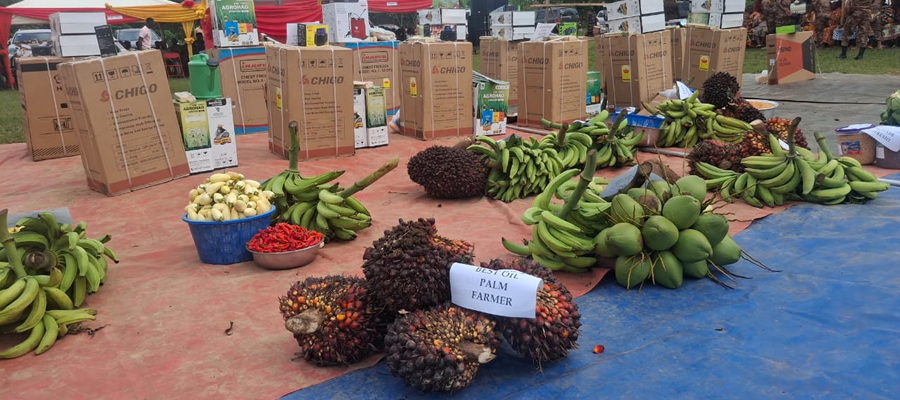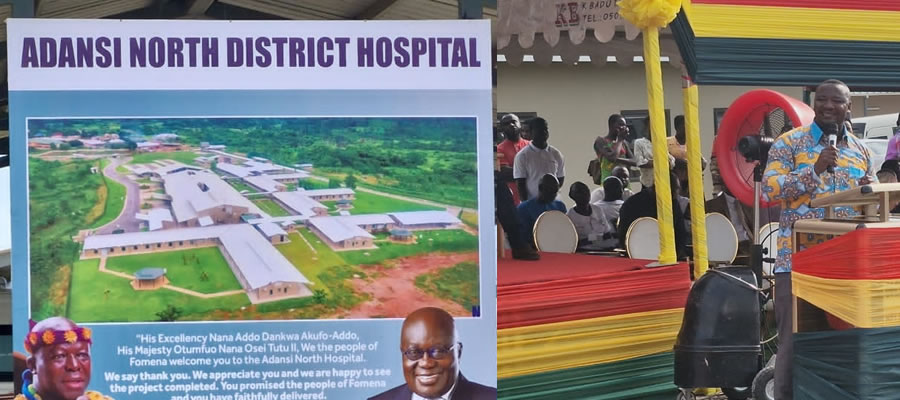

Agriculture which is the mainstay of the district economy employs about 77 percent of the labour force. The active male and female population percentage engaged in farming stand at 55male and 45 female. There is however, no clear-cut distinction between farmers who produce either cash or food crops and farmers engaged in the production of food crops and rearing of livestock, poultry and fish farming.
There are seventeen operational areas with regard to Agricultural Extension work, with one extension officer in each operational area. This gives an extension officer farmer ratio of 1:3575 compared with an ideal national standard of 1:300.
There are four main ways of land acquisition identified in the district, namely; Individual, family means, outright purchase and abunu orabusa. The average farm size in the district is estimated at 5.3 acres.
The district does well in food crops like cassava, cocoyam, maize, plantain, yam and vegetables. Production of cash crops such as cocoa citrus and oil palm is dominant.
Cocoa
Production of cocoa is dominant in the district. It substantially employs greater number of people in the district. The cocoa mass spraying and fertilizer Hi-Tech has also increased production tremendously. Cocoa production in Nsokote cocoa district alone is 119067 bags. SOURCE : Quality Control - Asokwa.
Oil Palm
Oil palm production is also carried out by most farmers and serve as food and cash crops. Currently a lot of farmers have gone into oil palm production due to the establishment of P.S.I. nursery at Akwansrem. Processing of the fruit into palm oil and marketing employs a large number of women in the sector.
Cassava
It is widely grown, and it has comparative advantage over other food crops. It is sold in its raw form or processed into gari. The Department of Food and Agriculture has introduced the high yielding varieties like Afisiafi, Abasafita and Tecbankye through the efforts of the P.S.I on cassava.
Citrus
Most farmers around Akrokerri, Bobriase, and Kwapia, are well known in citrus production. The name “Obuasi Ankaa woo”, is associated with oranges from these communities. About 70% of oranges produced in the district is from the area. Efforts are being made by the District Directorate of Agriculture to bring the farmers together under one umbrella. The farmers could source for funds to establish an orange processing plant, to produce fresh juice for sale. It is envisaged that patronage will be very good as the area is already known for its sweet and good quality oranges. This will also go a long way in creating employment and reducing poverty.
Maize
Production of maize is not being fully exploited. Farmers prefer the cultivation of local varieties to the improved varieties like obaatampa and mamaba which yield higher and have high protein content than the local varieties.
Plantain
Production of the crop is on the increase due to high demand and ready market. Apem, Oniaba, Asamienu and Apantu are the Common varieties produced by farmers.
Yam
Even though the soils are suitable for yam production only few farmers practise it. Yam tubers are always brought in from Techiman and Kintampo.
Vegetables
Vegetables are mostly grown during the dry season (Nov – March) Farmers are however, face water problems since there are no irrigation facilities, even though some rivers in the district are perennial.
Cocoa Nursery
The establishment of cocoa nursery by the District Assembly in collaboration with the District Agricultural Directorate will go a long way to enhance the cocoa sector. The Fumso cocoa seed station is located in the district. Most farmers who buy these pods for planting do not have the technical knowledge of raising the seedling nurseries.They plant staggerally, wasting most of the seeds.
This method of planting makes weed control very difficult, as most of the germinated seeds are slashed during weed control. Labour becomes relatively expensive and time wasting on such farmers fields. It will be more appropriate if seedlings are raised and sold to farmers at reasonable prices. The District Assembly should support MOFA to raise over 10,000 cocoa seedlings to be sold to cocoa farmers at reasonable prices.
Agro – Chemical Shops (Banned Chemicals)
Currently agro – chemical shops are being opened in communities like Bodwesango, Dompoase, Fumso, and Asokwa. This is due to the fact that farmers are catching up with the education on NO-TILLAGE by the District Directorate of Agriculture. Due to the high cost of farm labour, farmers now use these chemicals (weedicide) as an alternative for weed control. The District Directorate of Agriculture also makes regular checks, so that all banned chemicals are not sold to farmers.
Some Banned chemicals are:
- D.D.T
- All types of urden
- P.P. Kumakate
- Phiostexin for maize storage
Forestry
The district has four (4) forest reserves namely Fum headwaters, Adu Kofi forest reserve, Dampayaw forest reserve and Kusa ranges which are rich in timber and other forest resources, especially medicinal plants. Besides these forest reserves, large portions of the secondary forest in the district are being cultivated into teak and rubber plantations in areas like Akrokerri and Anhwiaso.
Live Stock
Majority of the total farming population are engaged in crop production to the detriment of livestock farming which is poorly patronized. It is estimated that about 15 percent of the farming population are in livestock production. The farm animals are mainly cattle, sheep, goat and grasscutter are produced in small scale levels. The average stock of sheep and goats per household is between 10 – 20.
Poultry
Commercial poultry farming is on the increase. The commercial poultry farmers use deep litter system technology, whilst the local birds and small ruminants are on the free range. Low level in the livestock production is due to high incidence of diseases and pest associated with the rain forest ecology coupled with the fact that there is only one Veterinary Technical Officer in the district. Diseases such as Rabies, worm infestation, PPR and CBPP in cats, dogs, sheep, goats and cattle and poultry diseases need the attention of qualified veterinary surgeon and laboratory.
Fishing
The low supply of fish in the district is due to lack of inland fishing. MOFA is however, making efforts to encourage farmers to establish fish ponds to boost fish production in the district. Fish is however brought by Fish-mongers from neighbouring Central Region
Date Created : 11/10/2017 5:30:36 AM













 facebook
facebook
 twitter
twitter
 Youtube
Youtube
 +233 593 831 280
+233 593 831 280 0800 430 430
0800 430 430 GPS: GE-231-4383
GPS: GE-231-4383 info@ghanadistricts.com
info@ghanadistricts.com Box GP1044, Accra, Ghana
Box GP1044, Accra, Ghana